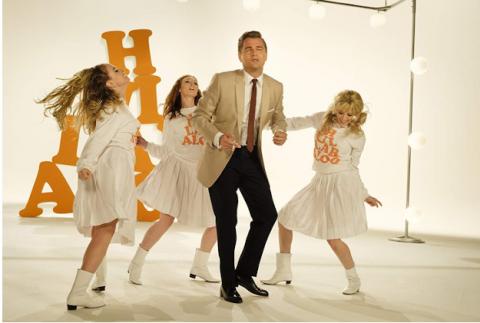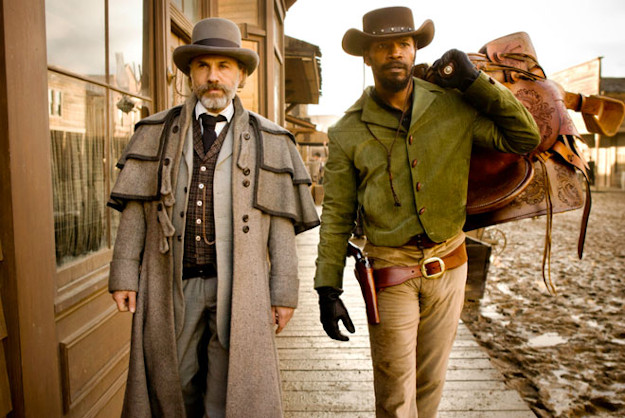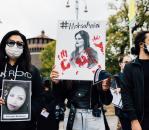Tarantino Delivers a Genius – and Peculiar – Masterpiece in ‘Once Upon a Time…’

Here’s the thing: Quentin Tarantino is an unqualified genius. Set aside his penchant for strong language, violence and revenge — those are merely the ornamental tools he uses as necessary. What separates him from every other filmmaker alive is his absolutely idiosyncratic gift for balancing measured rhythms with jazzy editing choices that make otherwise mundane scenes pop off the screen. And there’s a curious asymmetrical quality that permeates his style: Narrators appear and disappear; some of the Basterds get a flashy intro and others do not; why, exactly, does Uma Thurman’s Mia draw a dotted square onscreen? Well, because Tarantino is captivated by the cinematic possibilities of imbalance, the unexpected awesomeness of all that isn’t neat, tidy, and resolved.
It has been cynically suggested that Tarantino is the best worst filmmaker of all time. I understand exactly what this criticism is pointing toward, but I disagree. In essence, Tarantino catalogues and preserves outdated, obscure imagery and ideas from film history by improving upon them, revising them, enhancing them. As he told Empire magazine in 1994, “I steal from every single movie ever made,” and don’t consider the possibility that this statement is dated. He uses the word “steal” in the same context as T. S. Eliot, who wrote: “Immature poets imitate; mature poets steal.” Because of Tarantino’s unparalleled originality, his theft is a victimless crime; he absorbs, appropriates, and reconstructs the most compelling examples of moviemaking for the sake of his audience.
We have witnessed Tarantino’s growth as an artist, but his wildly unique sense of pacing has been his signature from the beginning. That’s why watching his best movies (and even his minor efforts) plug you into a heightened but recognizable version of reality. It’s surrealism made realistic. One might be tempted to reduce Pulp Fiction down to its over-the-top moments and the then-innovative loop built into the narrative, but those elements aren’t exactly what make that movie unique: It’s the novelistic, occasionally meandering but never boring pacing.
When Kubrick was developing Eyes Wide Shut with screenwriter Frederic Raphael, the director said “the way [Pulp Fiction] was told” is something they should consider as they crafted the script. Raphael didn’t think their story needed a loop like that, but Kubrick wasn’t referring to the loop. He was talking specifically about “the pace. Watch the pace.” It’s the unbearable leisurely pace of scenes, like the masterful opening of Inglorious Basterds or the dinner table scene in what is probably Tarantino’s greatest film, Django Unchained. His sense of novelistic pacing reached new heights in The Hateful Eight, even if, at times, the film unfolded as a play trapped rigidly within a proscenium arch.

Naturally, Tarantino stretches and further develops this enticing balance of purely cinematic visuals and naturalistic tempos in his ninth feature, Once Upon a Time…in Hollywood, the auteur’s most daring and brazen attempt to create a visual novel, a three-dimensional engineering of a story that feels like the Word made flesh. The setting is Los Angeles, 1969. The main characters are Rick Dalton (Leonardo DiCaprio), a heavy-drinking TV actor struggling to transition into more lucrative movies, and Cliff Booth (Brad Pitt), Rick’s best friend and stunt double. There is a lot of cruising around and vibing to a perfectly groovy soundtrack. Rick takes a gig in an Italian western. Cliff fixes an antenna on Rick’s roof. Also, there is a blonde named Sharon Tate (Margot Robbie) who attends parties with her husband, Roman Polanski (Rafal Zawierucha), and former lover, Jay Sebring (Emile Hirsch). Also, not far from the Hollywood Hills, where Rick’s house is a mere swooning crane shot from Sharon’s home, there is the Spahn Ranch where Charles Manson (Damon Herriman, in a cameo) and his pack of followers provide visitors with horse rides while secretly plotting a maniacal event that would throttle 1969 L.A. more violently than any earthquake.
But you already know this much from that mystifying trailer for the movie. What you don’t know is that the three aforementioned plot lines don’t meaningfully interact. The characters circle and pass by each other within the narrative, but there’s no ultimate checkmate. Tarantino made it very clear as early as 2017 that his movie is not “Charles Manson, it’s 1969.” This is an accurate characterization, so be forewarned. He also released a statement to the viewers of the premiere at Cannes imploring that “everyone avoids revealing anything that would prevent later audiences from experiencing the film in the same way” — a roundabout, and classically Tarantino, way of saying, “No Spoiler Alerts.” It’s also been reported that Robert Richardson, the DP on Once Upon a Time… wasn’t allowed to read the ending of the script until midway through production.
When these factors, along with that perplexingly oblique trailer, are taken into account, you might find yourself drawn to see this film out of sheer curiosity. After all, why would Tarantino cast nearly every single key figure from the Manson Family murders if the movie isn’t in some crucial way centered around the event sparked by Charles Manson and his spacey-eyed followers? Simply put, it’s because Tarantino wants us to live and bask in the sun-faded glow of a bygone era in Hollywood; a time when L.A. was a laidback town full of actors, artists, directors, beauties, drugs, parties, pools, and giant bottles of booze; a far-out Eden before the Fall. In this regard, the movie is both absorbing and pointedly peculiar. The easygoing pace gathers momentum as the characters drift toward the central event that we know must be coming. Even if you are unaware of any of the details of the Manson Family murders, you’re still expecting a Tarantinoesque showdown.
But the showdown doesn’t happen. Yes, there is a showdown of sorts, but it falls directly into the shaggy dog variety. If you know the story of Sharon Tate’s fate, the ending of Once Upon a Time… is baffling, bizarre and blithe; an anticlimax. If you possess zero knowledge about the events that unfolded on August 8-9, 1969, then the conclusion to this film makes almost zero sense. When you consider the arch of the narrative outside of its historical and cultural context, you realize you’ve been had.

Tarantino, a master storyteller, has opted to tell a classic “A priest, a rabbi, and an atheist walk into a bar…” joke, a goof, a one-off. After two and a half hours of listening to Tarantino’s often engaging but sometimes bloviating rendition of this classic joke, he concludes with the punchline that goes something like, “So the priest, the rabbi, and the atheist enjoy each other’s company, respect each other’s beliefs, and have an altogether wonderful evening. The end.” All the implied complications and challenges posed by the premise evaporate because, as this ending makes clear, the lengthy setup accomplishes little more than presenting an absolutely accurate portrayal of days in the life of industry professionals during a certain time. In terms of production and costume design, the film is stunning. But if you’re hoping for more than a pun-heavy punchline, place your hopes elsewhere.
Some critics have chosen to finger-wag about Tarantino’s playful approach to rewriting history, but the revision of historical events isn’t the problem. The reason viewers and critics alike leave the theater in a state of bewilderment has everything to do with Tarantino’s insufficient conclusion; the climax simply doesn’t work without wiping out the significance of the preceding two and a half hours. There was a general sense of confusion mingled with disappointment in the theater as the credits began to roll. I can’t be the only one who thought: So…is there going to be a volume two? One audience member stood up and loudly declared that it was the worst thing he’d ever seen and should ask for his money back. In the lobby, the same man was trying to explain the significance of the ending to his bleary-eyed and categorically uninterested son: “OK, so back in 1969, what actually happened was…” he began, irritably trying to add context to the non-event that occurs at the end of this picture. The ending makes the preceding build-up feel questionable at best and irrelevant at worst. There’s no tragedy or triumph — shouldn’t there be both?
The ending notwithstanding, there are times when the movie soars: The opening sequence that accompanies the credits is a breathtaking collage that plunges you completely into the headspace and milieu a different totally time. Brad Pitt gives the coolest performance of his career, and I mean “coolest” in the purest possible sense: cooler than Brando at his coolest, cooler than Steve McQueen (who appears as a character in the film long enough to give a monologue before disappearing completely). Pitt’s rapport with his dog is one of the more touching elements. DiCaprio is game as ever as Rick, and it’s especially appealing watching him commit to exploring the pathos of such a low-status character, stuttering and blinking and coughing and wallowing in self-pity. At times, the dialogue is perfunctory and bland, but sometimes the performances elevate the static lines to a Chekhovian level of subtext. There are disarming and supremely enjoyable outtakes, deliberate mis-takes, breaks and outlandish digressions. The craftsmanship is flooring and the formal qualities of Once Upon a Time… offer one of the year’s most fully realized color palates.
I don’t think Tarantino’s use of cinematic language has ever been better, but his refusal to provide a freak-out ending, as he did spectacularly in Django Unchained and Inglorious Basterds and, to a slightly less satisfying extent in The Hateful Eight, left me with a literal crick in my neck. I spent the final 40 minutes of the film tense with anticipation as I waited for the inevitable ending. The absence of a catharsis caused that crick to remain in my neck for the rest of the night. Because the tension was unresolved onscreen, the tension didn’t allow itself to be exorcized from my body.

Even though I know what transpired on that night in August in 1969, I’m also aware of the wildly mischievous liberties Tarantino imposes over historical events. Hitler and his Nazis are set aflame. The slave survives unthinkable odds to visit great vengeance and furious anger upon the slaveowners. A series of homicides leaves almost everyone dead. But Once Upon a Time… puzzlingly presents the first instance I’m aware of where Tarantino essentially says, “j/k, I’m not even gonna go there.” So was this decision made from a place of fear of backlash? Out of respect for the very real — and infamous — victims? Did he want to experiment with a counterintuitive approach to the type of climax we’ve come to not just expect but desire from him?
It’s likely that Tarantino isn’t terribly interested in the murders or Manson, which offers a compelling explanation for the flagrant lack of development of Sharon Tate as a character. (There is no chance of empathy; she’s reduced to wonderstruck smiles and carefree beauty. Plus, the actions assigned to her present no momentum to the story.) Rather, he’s more fascinated by the possibilities of recreating and toying with old school movies and clunky TV shows from the era. During these moments, his verve and energy come closest to reaching vibrancy. However, what he has mainly succeeded in is flawlessly crafting snippets of mediocre TV shows that aren’t in and of themselves that interesting — that’s how authentic they are, and they roll for long stretches as a time.
Once Upon a Time… is the most peculiar epic in his filmography, and perhaps it will become more lauded over time. Tarantino is such a master filmmaker that I’m not worthy of proofreading a single sentence he writes. E. B. White once quipped, “Genius is more often found in a cracked pot than a whole one.” Ultimately, in spite of whatever misgivings or criticisms or complaints that I have, I would take a cracked pot from a brilliant crackpot like Tarantino over any whole pot that graces the multiplex.
Author Bio:
Christopher Karr is a contributing writer at Highbrow Magazine.
For Highbrow Magazine






























































































































































































































































































































